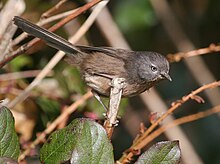Wrentit
| Wrentit | |
|---|---|

| |
| Scientific classification | |
| Domain: | Eukaryota |
| Kingdom: | Animalia |
| Phylum: | Chordata |
| Class: | Aves |
| Order: | Passeriformes |
| Family: | Paradoxornithidae |
| Genus: | Chamaea Gambel,1847 |
| Species: | C. fasciata
|
| Binomial name | |
| Chamaea fasciata (Gambel,1845)
| |

| |
Thewrentit(Chamaea fasciata) is a smallbirdthat lives inchaparral,oak woodlands,and bushland on the western coast ofNorth America.It is theonly speciesin thegenusChamaea.
Itssystematicshave been the subject of much debate, the wrentit having been placed in many differentfamiliesby different authors for as long as it has been known to science. Its common name reflects the uncertainty, and its external resemblance to bothtitsandwrens.It is not related to either, however. More recent and comprehensive phylogenetic studies support it belonging to theparrotbills.
Description
[edit]The wrentit is a small, 15 cm (5.9 in) bird with uniform dull olive, brown, or grayishplumage.It has short wings and a long tail often held high (hence the comparison to wrens). It has a shortbilland a pale iris. Given its retiring nature and loud voice, the wrentit is more likely to be detected by its call than by sight. The distinct sound that it makes is similar to the sound of a ping-pong ball falling on the table.
Systematics
[edit]The wrentit has been variously placed in its own family, the Chamaeidae, or with thelong-tailed tits(Aegithalidae), the true tits and chickadees (Paridae), the "Old World warblers" (Sylviidae), and with the "Old World babblers" (Timaliidae). TheAmerican Ornithologists' Unionplaces the wrentit in the latter family, giving it the distinction of being the only babbler known from theNew World.[2]This is based onDNA–DNA hybridizationstudies,[3]which arephenetic,however, and therefore not considered methodologically adequate today.[citation needed]
ThroughDNA sequenceanalysis, it was subsequently discovered that the wrentit was more closely allied toSylviawarblers and some aberrant "babblers".[4][5]These consequently must be placed in the familySylviidaetogether with the wrentit and theparrotbillswhich also turned out to be close relatives. Thus, the wrentit is the only American species of the "true" or sylviid warblers. Peculiarly, theDartford warblerand close relatives likeMarmora's warblerbear an uncanny resemblance to the wrentit;[6][7]their ecology is quite similar indeed, as all are birds ofMediterranean scrub.However,biogeographyand the molecular data build a strong case for this similarity being a case ofconvergent evolutionbetween birds that are close relatives but by far not as close as their appearance would suggest.
Alice Cibois suggested that as some babblers are closer to typical warblers than these are tomarsh-warblersfor example, the Sylviidae should be merged into the Timaliidae.[8]As such an abolishing of thesenior synonymwould require a formalInternational Commission on Zoological Nomenclatureruling and the typical warblers and relatives are still amonophyleticgroup at present, this proposal is not advanced by most researchers until the remaining Sylviidae and Timaliidae genera are studied as regards their relationships.[citation needed]
In 2019, a major taxonomic revision of species formerly classified as "babblers" recoveredChamaeaas being most closely allied with theparrotbillsandfulvettas,which are otherwise an exclusively Asian group. Due to their phylogenetic and morphological distinctiveness, the familyParadoxornithidaewas revived for this group, including the wrentit.[9]
Distribution
[edit]
The wrentit is a sedentary (non-migratory) resident of a narrow strip of coastal habitat along the western coast ofNorth America,being found fromOregonsouth throughCalifornia,toBaja California,the northern state of theBaja California peninsula.
It is usually restricted to certainchaparral and woodlandhabitats.It nests in 1 metre (3 ft) high shrubs such aspoison oak(Toxicodendron diversilobum),coyote bush(Baccharis pilularis) andCalifornia blackberry(Rubus ursinus). Logging and other changes in habitat have led to this species expanding its range recently, particularly northwards.
Ecology
[edit]Wrentits mate for life, forming pair bonds only a few months after hatching. Both sexes sing; the faster rhythm of the male's song is one of the few ways to differentiate the sexes. Both sexes also defend their territory year-round and participate in building the nest, a four-stage process that takes about two weeks. The three or four eggs are incubated for 14 days, again by both sexes. The chicksfledgeafter 15 days (at which stage they are unable to fly) and are fed by their parents for another 40 days.
The wrentit feeds by skulking through dense scrubgleaningexposed insects found by sight. It feeds primarily onbeetles,caterpillars,bugs, andants,but also takes small berries and seeds.
References
[edit]- ^BirdLife International (2016)."Chamaea fasciata".IUCN Red List of Threatened Species.2016:e.T22716861A94514854.doi:10.2305/IUCN.UK.2016-3.RLTS.T22716861A94514854.en.Retrieved12 November2021.
- ^"Check-list of North American Birds".American Ornithologists' Union. 1998–2006. Archived fromthe originalon 28 April 2007.Retrieved4 May2007.
- ^Sibley, Charles G.; Ahlquist, Jon E. (1982)."The Relationships of the Wrentit as Indicated by DNA-DNA Hybridization"(PDF).The Condor.84(1): 40–44.doi:10.2307/1367818.JSTOR1367818.
- ^Cibois, Alice (2003). "Mitochondrial DNA Phylogeny of Babblers (Timaliidae)".Auk.120(1): 1–20.doi:10.1642/0004-8038(2003)120[0035:MDPOBT]2.0.CO;2.JSTOR4090138.S2CID85629890.
- ^Pasquet, Eric; Bourdon, Estelle; Kalyakin, Mikhail V.; Cibois, Alice (2006). "The fulvettas (Alcippe), Timaliidae, Aves): a polyphyletic group ".Zoologica Scripta.35(6): 559–566.doi:10.1111/j.1463-6409.2006.00253.x.S2CID84546365.
- ^Helbig, A. J. (2001). "Phylogeny and biogeography of the genusSylvia".In Shirihai, Hadoram (ed.).Sylvia warblers.Princeton, N.J.: Princeton University Press. pp. 24–29.ISBN0-691-08833-0.
- ^Jønsson, Knud A.; Fjeldså, Jon (2006). "A phylogenetic supertree of oscine passerine birds (Aves: Passeri)".Zoologica Scripta.35(2): 149–186.doi:10.1111/j.1463-6409.2006.00221.x.S2CID85317440.
- ^Cibois, Alice (2003)."Sylviais a babbler: taxonomic implications for the families Sylviidae and Timaliidae ".Bulletin of the British Ornithologists' Club.123:257–261.
- ^Cai, Tianlong; Cibois, Alice; Alström, Per; Moyle, Robert G.; Kennedy, Jonathan D.; Shao, Shimiao; Zhang, Ruiying; Irestedt, Martin; Ericson, Per G.P.; Gelang, Magnus; Qu, Yanhua (January 2019)."Near-complete phylogeny and taxonomic revision of the world's babblers (Aves: Passeriformes)".Molecular Phylogenetics and Evolution.130:346–356.Bibcode:2019MolPE.130..346C.doi:10.1016/j.ympev.2018.10.010.ISSN1055-7903.PMID30321696.S2CID53216358.
Further reading
[edit]- Collar, N. J.; Robson, C. (2007). "Family Timaliidae (Babblers)". In del Hoyo, J.; Elliott, A.; Christie, D. A. (eds.).Handbook of the Birds of the World.Volume 12. Picathartes to Tits and Chickadees.Barcelona: Lynx Edicions. pp. 70–291.
- Wrentit Species Account– Cornell Lab of Ornithology
External links
[edit]- "Wrentit media".Internet Bird Collection.
- Wrentit photo galleryat VIREO (Drexel University)
- Interactive range map ofChamaea fasciataatIUCN Red List maps

